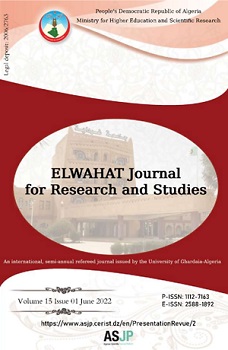Contribution au calcul simplifié de la correction orthométrique en nivellement de précision
Abstract
The height of a point, generally useful to ensure the direction of runoff waters, is the coordinate which is expressed by the vertical distance between this point and a reference surface. Thus, several types of heights are defined. As for orthometric heights, the considered reference surface is an equipotential surface of the Earth's gravity field, corresponding approximately to the mean sea level (geoid).
The equipotential surfaces are not parallel; it is not possible to set the altitude as a simple geometric height above a reference surface. Thus, the geometric height differences between points measured step by step from a fundamental point with a precision leveling method should be corrected by taking into account the variations of gravity. The estimation of this correction, known as orthometric correction, that we will have to make to the measured height differences can be done through two approaches. The first known as the normal orthometric correction is based on normal gravity (or theoretical). The second form is a rigorous approach that includes the real gravity measurements in leveling.
This paper has therefore examined the theory and practical possibility to estimate the orthometric corrections for precise leveling networks. A computer program dedicated to numerical estimation of normal orthometric corrections in its three possible forms and the so-called Helmert correction was developed. Leveling data set covering the Perth area Australia was used to validate the reliability of this program, which provides conclusive results.
Key words: height, observed gravity, normal gravity, normal orthometric correction, Helmert's orthometric correction.
References
Bowie W. and Avers H.G., 1914.- Fourth General Adjustment of the Precise Level Net in the United States and the Resulting Standard Elevation, Special Publication No. 18, U.S. Coast & Geodetic Survey, Government Printing Office, Washington, D.C., 328 p.
Heiskanen W.A. and Moritz H., 1967.- Physical Geodesy, W.H. Freeman and Co., San Francisco.
Iasky R.P., 1993.- A structural study of the southern Perth basin,
Western Australia., Geological Survey of Western Australia. Report, vol. 31, 56 p.
Kao SP., Rongshin H., Ning FS., 2000.- Results of field test for computing orthometric correction based on measured gravity, Geomatics Research Australasia, vol. 72: 43-60.
Ministère des Ressources naturelles et de la Faune, 2010.- Guide sur les référentiels géodésiques et altimétriques au Québec. https://www.mern.gouv.qc.ca/publications/territoire/outils/guide_sur_les_referentiels.pdf
Moritz H., 1980.- Geodetic reference system 1980, Bulletin Géodésique, vol. 54: 395-405.
Nocquet JM., Duquenne H., Boucher C., Harmel A., Willis P., 2000.- Conversion altimétrique RGF93-IGN69, Correction des altitudes GPS en France. Conseil National de l’Information Géographique - France. http://bazar.perso.free.fr/Files/Other/DOCUMENTATION/topo/conv_alti%20IGN93-RGF69.pdf. Accédé le 02 février 2015.
Rapp RH., 1961.- The orthometric height, M.S. Thesis, Department of Geodetic Science, Ohio State University, Columbus, USA.
Roelse A., Granger H.W., Graham J.W., 1971.- The adjustment of the Australian levelling survey 1970-1971, Technical Report 12, Division of National Mapping (now AUSLIG), Canberra, Australia.
Strange W.E., 1982.- An evaluation of orthometric height accuracy using borehole gravimetry, Bulletin Géodésique, vol. 56: 300-311.






